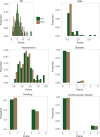Long-term predictive value of the Framingham Risk Score for Stroke in HIV-positive vs HIV-negative men
- PMID: 24212385
- PMCID: PMC3863354
- DOI: 10.1212/01.wnl.0000437296.97946.73
Long-term predictive value of the Framingham Risk Score for Stroke in HIV-positive vs HIV-negative men
Abstract
Objective: To test the predictive accuracy of the Framingham Risk Score for Stroke (FRS-S) in HIV-infected (HIV+) vs HIV-uninfected (HIV-) men.
Methods: The Multicenter AIDS Cohort Study (MACS) is an ongoing prospective study of HIV+ and HIV- men who have sex with men (MSM) enrolled in 4 US cities. We ascertained all reported stroke events during a recent 15-year timeframe (July 1, 1996 to June 30, 2011) among 3,945 participants (1,776 HIV+ and 2,169 HIV-). For those with strokes, FRS-S were calculated 10 years before the stroke event and assessed according to HIV status.
Results: A total of 114 stroke events occurred, including 57 HIV+ and 37 HIV- participants with first-ever strokes and 19 fatal strokes. The incidence of first-ever stroke was 1.7/1,000 person-years among HIV- and 3.3/1,000 person-years among HIV+ participants. Among those with strokes, HIV+ participants were younger than HIV- participants (median age 51.3 vs 61.8 years, p < 0.0001). For these men with stroke, the average 10-year risk of stroke was higher for HIV- MSM (6.6% [range 3%-26%] vs 4.9% for HIV+ MSM [range 0%-15%], p < 0.04). Traditional risk factors for stroke were similar among the Framingham cohort and the MACS HIV+ and HIV- participants.
Conclusions: FRS-S prediction was systematically different in HIV+ vs HIV- men with stroke events. The FRS-S underestimates the long-term risk of stroke in HIV+ men.
Figures


References
-
- Wolf PA, D'Agostino RB, Belanger AJ, Kannel WB. Probability of stroke: a risk profile from the Framingham Study. Stroke 1991;22:312–318 - PubMed
-
- Friis-Møller N, Thiébaut R, Reiss P, et al. ; DAD Study Group Predicting the risk of cardiovascular disease in HIV-infected patients: the Data Collection on Adverse Effects of Anti-HIV Drugs Study. Eur J Cardiovasc Prev Rehabil 2010;17:491–501 - PubMed
-
- Hasse B, Ledergerber B, Furrer H, et al. Morbidity and aging in HIV-infected persons: the Swiss HIV Cohort Study. Clin Infect Dis 2011;53:1130–1139 - PubMed
-
- Rasmussen LD, Engsig FN, Christensen H, et al. Risk of cerebrovascular events in persons with and without HIV: a Danish nationwide population-based cohort study. AIDS 2011;25:1637–1646 - PubMed
Publication types
MeSH terms
Grants and funding
LinkOut - more resources
Full Text Sources
Other Literature Sources
Medical
Miscellaneous
